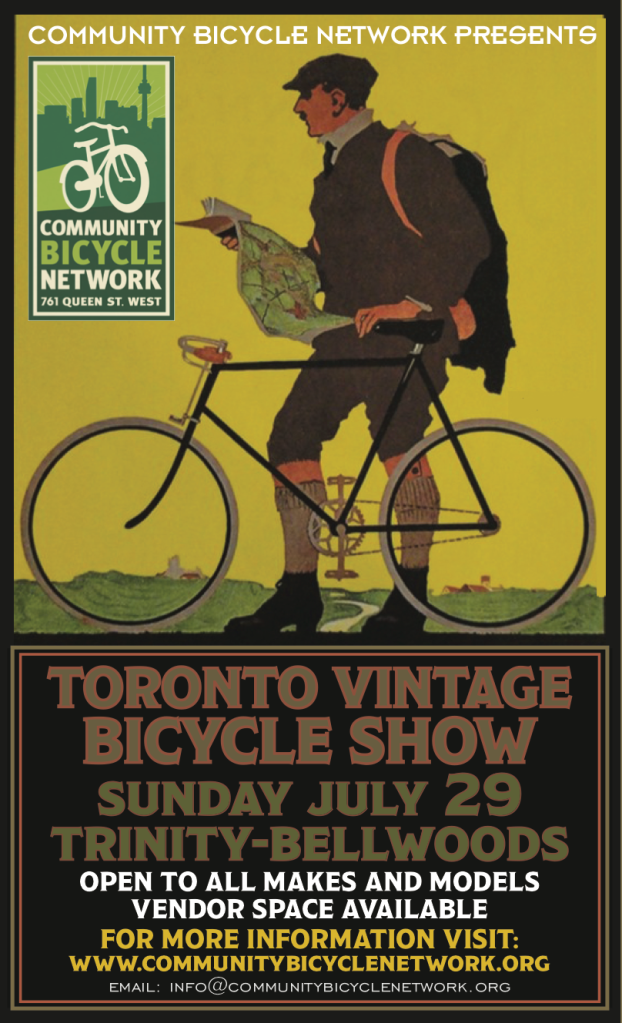Archives

It was in September 1899 that Walter Massey, in an attempt to strengthen his family’s position as Canada’s largest bicycle maker, amalgamated his bicycle works with that of the Welland Vale Manufacturing Co. of St. Catharines, the Goold Bicycle Co. of Brantford and the H.A. Lozier & Co. and the Gendron Mfg. Co., both of Toronto, to form what Massey and his partners called Canada Cycle & Motor Co. Ltd. (CCM).
 Based in Toledo, Ohio, the Gendron Mfg. Co. had been established by Peter Gendron (1844 - 1911) who, in 1865, at the age of 21, had left his father’s wagon works in St. Ours, Quebec, to move to Ohio where he found employment as a pattern maker for the Toledo Novelty Works. By 1871 Gendron had established his own business.
Based in Toledo, Ohio, the Gendron Mfg. Co. had been established by Peter Gendron (1844 - 1911) who, in 1865, at the age of 21, had left his father’s wagon works in St. Ours, Quebec, to move to Ohio where he found employment as a pattern maker for the Toledo Novelty Works. By 1871 Gendron had established his own business.
In 1874 the ingenious young French-Canadian was granted a patent for a lightweight, wire-spoke wheel he had designed. The wheel was quickly found to be more durable and much superior to the heavy, solid wooden wheels of the time. Gendron incorporated ball bearings into the hub to reduce the wear on the wheel as it turned on the axle and in 1880 established the Gendron Wheel Co. to install his invention on everything from baby buggies and doll carriages to wagons and wheelchairs. The first vehicles to use the new Gendron wheel were the large adult tricycles of the 1800’s.

In 1895 Gendron established the Gendron Mfg. Co. of Toronto and built an impressive brick factory at 411 Richmond St. in Toronto. Here his company began to produce not only bicycles and tricycles, but doll carriages and other children's toys as well.

Producing bicycles under the brand names of Gendron and Reliance, the Gendron Mfg. Co. claimed their bicycles were the fastest in the country. It was a feat, they said, made possible by the use of a three-point bearing in its wheels and a fact clearly demonstrated when the Rambler’s Bicycle Club of Toronto held a five-mile race at the Woodbine track on July 30, 1896.
At the meet the company noted that seventeen of the twenty competitors rode Gendron-made bicycles. Following the race the company promptly announced that the three competitors riding other makes had finished dead last.
Spurred by such success, the Gendron company challenged its competitors: “Now gentlemen of the old-fashioned bearing fame, you have long been preaching the excellence of your bearings, now is the time to give us proofs. Show us your credentials and give the public an account of your achievements. We are weary of your silly arguments. Substantiate your claims or keep quiet.” (1)
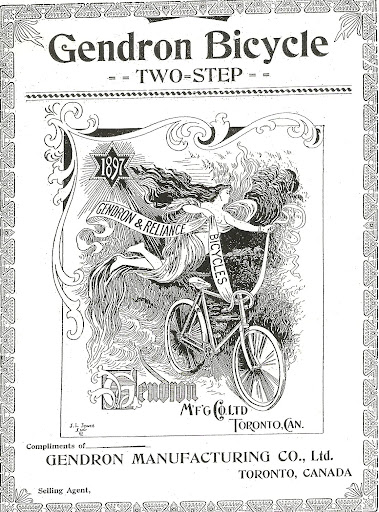
In July 1896 when the Goold Bicycle Co. of Brantford announced that its tandem bicycle had never been beaten in a race, the Gendron company pointed out that the only reason the Goold tandem had never been beaten was that it had never actually been in a race!
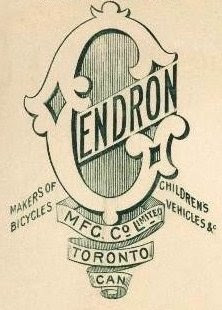
It was a dig that prompted the Brantford company to retort that the Gendron company knew more about “fancy frills and baby-carriage wheels” than it actually did about bicycles, a statement the Gendron folks dismissed as “the most contemptible style of advertisement ever printed in a Toronto paper.” (2)
The barbs continued to fly as the Gendron Mfg. Co. accused the Goold company of producing bicycles with “white-washed” rims, citing the tale of poor Harry Parkin, who, according to the Gendron company, was riding a Goold bicycle out the Kingston Road when the front forks gave out, causing the unfortunate cyclist to suffer “forty-eight hours of unconsciousness, six weeks in hospital, a scar on his face and a heavy bill for repairs.” (3)
The Gendron Mfg. Co. remained a major player in the Canadian bicycle market until the sale of its cycle works to CCM in 1899, following which the company turned its attention to the motor car. By 1920 Gendron had become the world’s largest maker of children’s pedal cars, manufactured to imitate the full-sized automobiles of the day. Sold under the name of Pioneer, the Gendron brand became synonymous with high quality pedal cars that featured cylindrical rear gas tanks, tool boxes, imitation cranks, and nickel trim.

The company stopped making children's vehicles in 1941, but continued to make wheelchairs and other hospital equipment.
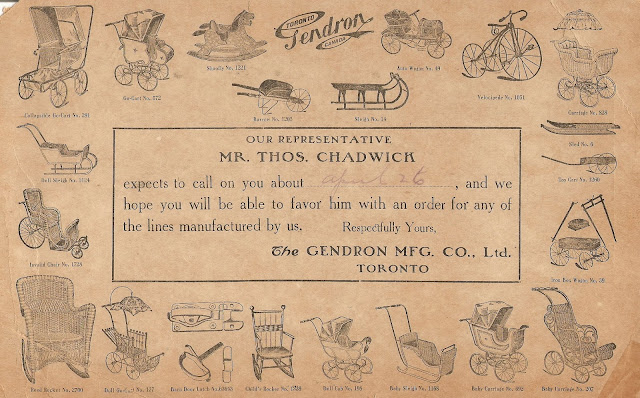
1. Daily Mail & Empire, May 29, 1897
2. "We Beg to Tender Our Hearty Thanks to a Firm Handling Bicycles," The Globe, August 1, 1896
3. ibid.
A Skate Magician
© John McKenty 2012
Born in 1948, I moved with my family to the village of Portsmouth, Ontario, just shortly after it was annexed by the city of Kingston in 1952. It was a union given little attention by the villagers who went about their daily lives as if they were still a recognizable entity unto themselves.
While Portsmouth had the usual small-town amenities such as a corner store (Beckie's), a drug store (Peter's), a barber shop (Ernie's), a hardware (Baiden’s) and a Red & White (Cowan's), it also had an “insane asylum” (Rockwood), as it was known at the time, two rather rowdy hotels (Lakeview Manor & Portsmouth House), as well as two maximum security prisons, one for the men and one for the women. It also had two schools and two churches, one each for the Catholics and the Protestants. Pretty heady stuff for a community of about 500.
With the hotels and prisons standing as a stark reminder of what can happen when one is led astray, it was around this time that local building contractor Harold Harvey, bothered by the frequent sight of children playing in the streets or just hanging out, founded the Church Athletic League, an organization offering recreational hockey, softball, basketball and bowling for young people. The one stipulation was that all participants must attend church or Sunday School 80% of the time. It was Mr. Harvey’s valiant attempt to set the village's and the rest of the city’s youngsters in the right direction.

When the Church Athletic League began its first season of hockey in 1951, it had 100 boys signed up. As the league continued to grow, however, Harvey came up with a plan for a new outdoor rink to be built at the old quarry in Portsmouth, where 19th-century prisoners had once hammered limestone into building blocks. So it was that the Harold Harvey Arena was constructed in 1960 at 42 Church Street, directly across from where I lived at 35 Church St. Over time, my two brothers and I, as well as our dad, would work at the venerable old arena which would begin life as an open-air affair, before eventually being closed in.

Back in those days everyone in Portsmouth brought their skates to Baiden's Hardware to be sharpened. It was a retail operation overseen by Henry Baiden and his younger brother Bill. The problem, according to many in the village, was that Bill knew how to sharpen skates correctly, but Henry didn’t. As a result, before you took your skates in to be done, you peered cautiously around the corner of the store’s front window to ensure that Henry was busy and Bill was not.
 It had long been known that sharpening a skate blade properly was an art form not easily mastered by just anyone, a fact acknowledged by the Toronto Maple Leafs, who for years came to depend upon the team's equipment manager, Tommy Naylor, to keep their blades finely tuned. Naylor’s reputation as a master on the skate machine was such that he would eventually be asked to accompany Team Canada to Europe for the Summit Series in 1972.
It had long been known that sharpening a skate blade properly was an art form not easily mastered by just anyone, a fact acknowledged by the Toronto Maple Leafs, who for years came to depend upon the team's equipment manager, Tommy Naylor, to keep their blades finely tuned. Naylor’s reputation as a master on the skate machine was such that he would eventually be asked to accompany Team Canada to Europe for the Summit Series in 1972.
A summer employee of CCM, Tommy Naylor was born in 1904 and was first employed as a messenger boy for the A.G. Spalding & Bros. Sporting Goods Co. in Toronto. When the regular skate sharpener quit, the company offered the job to Tommy, who, at the time, was also the stick boy for the Toronto Arenas. Tommy took the skate-sharpening job, eventually ending up with the Leafs, where he was variously listed as the team’s assistant trainer or equipment manager.
Among those who praised the way Naylor handled his skates was perennial Leaf all-star King Clancy.
“He never rockered them and I went along with that. Some players liked them that way, but I preferred flat, believing that the more blade you had on the ice, the faster you could go,” said Clancy. (1)
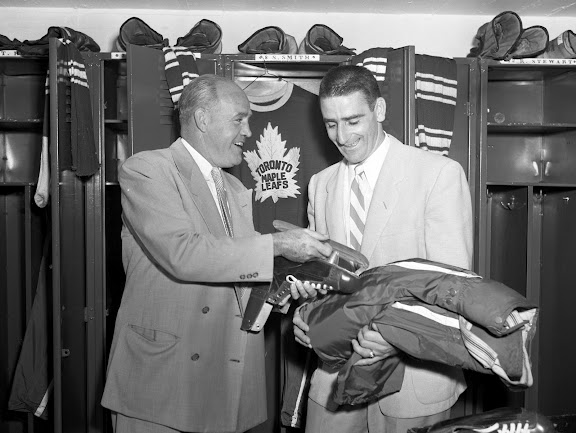
Working in a room under the stairs at the north-east corner of Maple Leaf Gardens, Naylor was sought out by the leading skaters of the day. In 1936 when CCM sent a shipment of skates to Los Angeles for use in her ice show, Sonja Henie, who was notoriously finicky, wanted Naylor to accompany the skates, but he declined.
Henie wasn’t the only famous figure skater to seek out the expertise of Tommy Naylor. Prior to her departure for Europe and world acclaim in 1948, Canada’s sweetheart, Barbara Ann Scott, also paid a visit to Naylor who had been sharpening her skates since she was seven.
Frick and Frack, two comic Swiss skaters, who performed as members of the Ice Follies, seldom appeared in Toronto without looking up Naylor, whom they called the top “skate man” in the world.
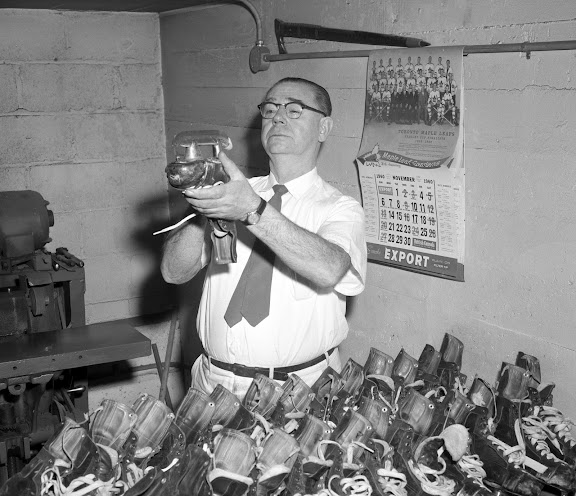
George Hayes, a linesman for twenty years in the NHL, recalled visiting Naylor in his skate room where the walls were covered with old photos, hockey calendars and newspaper clippings.
“He always did a fine job and wouldn’t give them to you if they weren’t just right. He always shellacked the toes of your skate boots and if your laces were a little worn, he’d put in a new pair. Then he’d say, ‘Compliments of the Toronto Maple Leafs,’ but we’d always make him take something a smoke or a beer,” recalled Hayes. (2)
Naylor was such an integral part of the Leaf operation that in 1951 when Conn Smythe, owner of the Leafs, looked at the annual team photo he inquired as to why Tommy Naylor wasn’t in the picture. When told that Naylor hadn’t been asked, Smythe bellowed, “Get the team together with him and take another photo!” (3). From then on, Tommy Naylor was in every official Toronto Maple Leaf photo.
When he wasn’t working on skates Tommy Naylor used his time to try and improve the quality of the equipment being used, including the creation of a trapper glove that goalies could wear. It was following a chance encounter with baseball’s George McQuinn of the Toronto Maple Leafs in the International League that Naylor used the first basemen's glove to come up with a definitive piece of goalie equipment.
“Well I took his old glove and I put a cuff on it and I gave it to Baz Bastien who played goal for the Senior Marlboros.” (4)
The success of the endeavour convinced Naylor to sew a strip of leather in Maple Leaf netminder Turk Broda’s catching glove which up to that time had only had a lace between the thumb and the forefinger. The reworked glove performed so well for Broda that soon goalies throughout the league were looking for one.
When Hap Day of the St. Pats cut his Achilles Tendon in 1926, Naylor used a most unusual item to come up with some protection for the back of Day’s ankles.
“Well I took the stays out of ladies corsets and shaped them down and slid them into nylon pockets, and sewed this into the heel of the hockey boots. These were the first Achilles-tendon guards. I did the same thing on the tongues of Teeder Kennedy’s boots. He was always getting cut on his instep,” explained Naylor. (5)
Naylor used the same principle to add ligament shields to a player’s shin pads and to develop the padded guards most defencemen would end up wearing around their ankles.
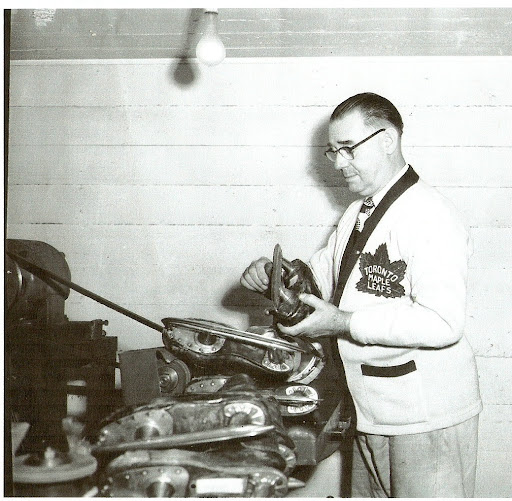


Over the years, despite the ongoing upgrade in equipment, the sharp end of a skate blade remained a constant threat to player safety. Prior to the start of the 1959/60 NHL season, CCM announced that Maple Leaf centre Red Kelly would be wearing a new type of guard on the end of his skate blade. Designed by CCM engineer Bill Shaw, it had been developed in consultation with Tommy Naylor.
The need for such a piece had been intensified when Leaf defenceman Allan Stanley fell in a game against the Montreal Canadiens striking his cheek against the back of Bill Hicke’s skate blade. Stanley came away from the encounter with twenty-five stitches and a broken jaw.
Following the game, Canadiens’ coach Toe Blake suggested that a metal guard connecting the end of the blade to the bottom of the boot should be standard on all skates. Naylor wasn’t so sure.
“There’s no guarantee that’ll prevent injuries. It’s much more important to round that part off when the skate is being sharpened,” maintained the soft-spoken Naylor. (6)
So it was that he and Shaw set about designing and refining the plastic tip which would soon be adopted by all the major skate manufacturers.
There were many who held that if the unassuming Naylor had patented all the inventions he had come up with, he’d have retired a millionaire. But Tommy Naylor didn’t do it for the money and nobody knew that better than Vic Hunt.
A goalie with the Toronto Dukes Jr. B Club, Hunt had been just eighteen years old when his hand was crushed by a press machine at the printing plant where he worked. The doctors had no choice but to amputate eventually fitting Vic with a hook for the stub of his right arm. While Conn Smythe offered to make the lad the Maple Leafs’ stick boy so he could stay involved with hockey, Vic Hunt had a different idea, one that needed the talent of Tommy Naylor.
Working with Hunt, over time Naylor rigged up an attachment that he bolted to the handle of the young man's goalie stick. With the attachment fitting into the hook of his right arm, Vic Hunt used a specially-designed hockey glove to cover the apparatus and to fulfill his dream of returning to the ice. Helping dreams come true was what Tommy Naylor did, but he didn’t do it for the money.
(1) King Clancy and Brian McFarlane, Clancy, (Toronto: ECW Press), 1997, p.95
(2) George Hayes. "Naylor Belonged," Daily Sentinel-Review, Feb 18, 1981
(3) ibid.
(4) Trent Frayne, "Our Memories & Foster Hewitt's Voice Made It Toronto's Most Famous Building," Toronto Star, Oct. 3, 1970
(5) ibid.
(6) Jim Proudfoot, "Skate Guards Could Worsen Injury - Naylor," Toronto Star, Dec. 9, 1960
2012 Canadian Vintage Bicycle Show
Story and photos by Mike Badyk
Reprinted with the kind permission of Canadian Cyclist www.canadiancyclist.com
Many cyclists focus only on the new in the bicycle world, but there are plenty of folks who fondly look back to the history of our beloved sport. A case in point was the 11th Annual Canadian Vintage Bicycle Show taking place on June 24th. The venue was the Heritage View Farm in Brantford, Ontario (and right across the street from the Alexander Graham Bell Homestead). In many respects it is reminiscent of a car show, with manicured lawns and ornamental trees as the backdrop to the various booths.
The show is the passion of Jamie McGregor, who had on display not only a huge collection of vintage bicycles, but also an abundance of 60’s vintage “muscle bikes”. If you’re unfamiliar with the term think of 20” wheeled CCM Mustangs, Raleigh Choppers and Schwinn Stingrays. Jamie doesn’t have a store. “I just collect. I sell some things but it’s not really my focus. It’s important to hang on to all parts of our cycling history.”
Even though there is a commonality of being vintage bikes, there are several sub categories present. The core is the really vintage – bikes over 100 years old. Many of them are Canadian too, showing that we were in the thick of bicycle production. There are a wide variety of balloon tire/cruiser bikes from the 30’s through the 60’s. Then there were the aforementioned muscle bikes from the 60’s, joined by some vintage road racers.

One other category that I have only a little knowledge of is the “Rat Rod Bike”. These are customized bikes based on vintage cruisers. One of the standout bikes at the show was Ken Martin’s CCM Rat Rod. The frame is a 1938 CCM Flyte, which is an Art Deco style absolutely unique to Canada. The paint scheme is based on a 1936 CCM. Besides the saddle from the 30’s, this beauty is a mash up of new parts, new old stock parts and what ever else Ken wanted to do. “I was entering a Rat Rod contest, sort of at the last minute, and I did this bike in just 2 weeks. It is one of those happy accidents where everything just came together. This bike finished 4th in a worldwide competition. I’m really proud of it. So proud that it’s definitely not for sale.” Ken does have some CCM frames and forks for sale though. If you’re interested in this genre of bike visit www.ratrodbikes.com

If you’ve ever seen vintage bikes then you know that many of the modern day innovations were actually tried 100 years ago. There were shaft drive bikes (see the Columbia below), full suspension bikes, racing bikes and utilitarian bikes. Check out this vintage Hartford from 1889. There are so many attempts at innovation on it that it is unbelievable. For all you GoPro users, there is a camera mount on the handlebar.


Some of the cruisers were very pretty. Here are two nice examples; an un-restored Western Flyer and the futuristic Silver King.


If you’ve ever had a desire to get a vintage bike then you’d probably want to try one. There is now a way to do this. A new company called Vintage Velo is about to open in Niagara-on-the-Lake. They have decided to take vintage bikes, restore them, and use them in their rental fleet. This show was their first official event. They have 70’s vintage Schwinns, 60’s CCM’s, and even a couple of 20 year old mountain bikes. They had some really neat bikes that could be just the thing to complete your Niagara visit. The web site is still a work in progress but you can visit them at www.vintage-velo.com


Even though muscle bikes are part of my childhood, my bicycle nostalgia really starts with my first road racing bikes in the late 1960’s. To my surprise I saw an example of my first proper road-racing bike. This is a 1970 Gitane Tour de France. Ah yes. A definite wave of deja vu. I had the same colour too. Sorry I sold it. Like 30 some odd years ago. Good thing this one was too small for me. There's always the danger of coming home with something you didn't intend to at shows like this.

If you’ve never been to the Canadian Vintage Bicycle Show it is well worth the visit. The venue is just gorgeous and the volunteers are super friendly and helpful. The modest admission goes to the Stedman Community Hospice. Check out the event at www.canadianvintagebicycleshow.com I have a sneaking suspicion that this going to become an annual event for my family.
Extra photo – Wilson Tandem – vintage unknown – From Wilson’s Music Store in Sarnia Ontario. Muscle bike display in the background.

MEC Bikefest Toronto
Saturday, June 23, 2012 at the Distillery Historic District
11:00am to 5:30pm

About MEC Bikefest
MEC Bikefest is a daylong community celebration of all things bicycle related. Our goal is to bring together Toronto’s bicycle community and those new to bikes, to celebrate the wonders of cycling. Come join us and make it the best bicycle bash in Toronto.
This free event has something for everyone, so bring the whole family down to the sweetest cycling celebration of the summer.
Workshops and clinics are $5 each with proceeds being donated to our community partner, Cycle Toronto (formerly the Toronto Cyclists Union). Group Rides are free, however registration is required as space is limited. MEC Bikefest happens rain or shine so please dress for the weather. Be prepared for both warm temperatures and rain. Food and snacks will be available for purchase, or you are welcome to bring your own. And don’t forget your water bottle.
Event description
Along with fun and festivities, MEC Bikefest is a hub of knowledge where cyclists new and old can make connections and get the information they need to pursue their passion. Proceeds from this event will be donated to our non-profit partner, the Cycle Toronto.
MEC Bikefest Toronto features activities for cyclists of all skill levels, including:
- Dozens of bike clinics and seminars (presented by MEC, Urbane Cyclist and Hardwood Ski & Bike)
- Bike demos
- Free bicycle safety checks
- Bike valet parking (provided by Cycle Toronto, formerly the Toronto Cyclists Union)
- Free basic repairs and tune-ups (provided by Bike Chain, Bike Pirates, Bike Sauce, Community Bicycle Network and Evergreen Bike Works)
- MEC Bikefest Bike and Gear Swap
- MEC Marketplace
- Local bicycle retailers and exhibitor booths
- Community and cycling advocacy information
- Free drop-in activities for kids
Location
MEC Bikefest Toronto happens downtown in the Distillery Historic District, on Parliament and Mill Street. Ride your bike to the festival – there will be bike valet parking on site. If you are driving, there is ample pay parking available on streets in the area.
SUNDAY, JUNE 24
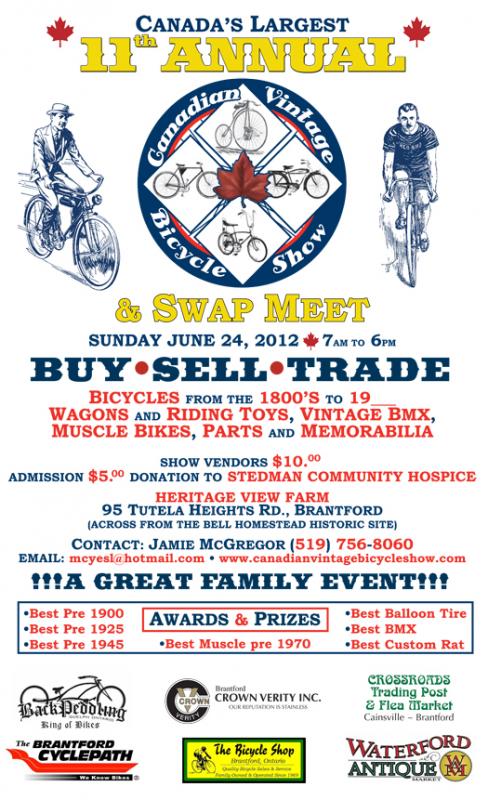

From a few years back:
Record crowd attends Canadian Vintage Bicycle Show
by Heather Ibbotson, Brantford Expositor
Monday, June 28, 2010
 Antique and vintage bicycle fans from across Brant County and beyond were drawn to a farm on Tutela Heights Road on Sunday for the ninth annual Canadian Vintage Bicycle Show.
Antique and vintage bicycle fans from across Brant County and beyond were drawn to a farm on Tutela Heights Road on Sunday for the ninth annual Canadian Vintage Bicycle Show.
Bicycle buff, Ryan O'Brien of Toronto, was one of the early birds and he was impressed by what he saw.
"This is beautiful. I'm surprised at the selection," O'Brien said. "There are some unique pieces."
O'Brien, a member of a Toronto bicycle club called the Devil Strip Rollers, said he enjoys antique bikes and the ingenuity that went into their designs.
"Cycling is so driven by technology these days," he said.
Show organizer Jamie McGregor was confident of a great crowd at this year's event.
"We'll have a record turnout. No doubt," he said shortly after 9 a.m. on Sunday. "I've never seen so many (people) here this early."
More than 50 vendors and their wares dotted the large well-tended property of Jody and Bonnie Varey, who have welcomed the bicycle show to Heritage View Farm for the past five years.
Two-wheeled treasures ranged from those made in the late 1800s to about 1975. "We've got a good range of all eras," McGregor said.
Vendors on the site displayed a huge variety of bicycles, from the so-called "muscle bikes" of the late 1960s and 1970s with their high handlebars and banana seats to the towering Victorian high wheel (or Penny-farthing) with its massive front wheel and tiny rear wheel.
Spare parts were also available in abundance and buyers weren't shy about shelling out the cash. One woman bought a vintage bicycle seat with mammoth springs for $65; another bought a sprocket for $10.
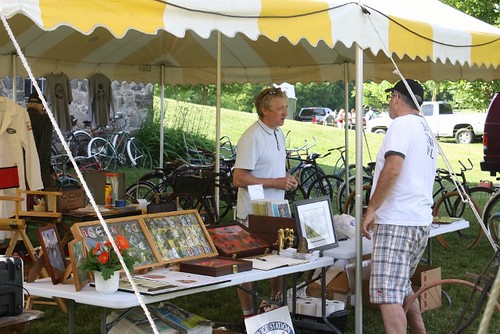
Roger Tupper, of Hamilton, displayed treasures including a 54-inch high wheel made in 1887 by the U.S.-based Columbia bicycle company.
With a leather seat perched atop a huge solid rubber tire, and with only a hand brake to slow down, the high wheel does not look like an easy ride, even if the rider did overcome the hurdle of figuring out how to get on top of it in the first place.
Tupper said high wheel bicycles are not as intimidating to ride as they look. "I got the hang of it pretty quickly," he said.
Still. the contraption is finicky and even hitting a stone can completely send a rider head over heels, he said.
Costing a hefty $100 in their day, high wheels were expensive diversions for the well-heeled. These antique bicycles can now run from $4,500 up to$20,000, Tupper said.
Admittance to the show was a $5 donation to the Stedman Community Hospice. For the past three years, McGregor has used the event to do a bit of fundraising to thank the hospice for the care provided to his father, John, who died there four years ago.
Reprinted with the kind permission of the Brantford Expositor.
Introduced in 1936 the CCM Flyte would become the most sought after of CCM's numerous bicycle lines. Designed by company employee Harvey Peace it was the only bicycle design for which Canada Cycle & Motor Ltd. actually sought a patent.
The Patent Application
The principal objects of the invention are to provide a bicycle of an unusual novel and attractive appearance which will have a distinct appeal to the eye in conformance with the line adopted in the streamlining of vechicles and further, to utilize the treamline effect of design to accomplish a very distinct improvement in the riding qualities of the bicycle to the effect the absorbing of road shocks and further, to provide a very desirable form of bicycle having a distinctly novel appeal. The principal features of the invention consist in the novel construction of the main frame whereby the upper bar is curved to meet the rear ends of the lower fork and to form a continuous part therewith and the front forks are curved downwardly with their lower ends bent rearwardly to form a resilient front support corresponding in part with the resilient rear fork.
In the manufacture of bicycles, it has been the practice for many years to construct the frame in accordance with a "standard" pattern which in side elevation is substantially diamond-shape or of a rhomboid formation with the rear forks extending substantially horizonally from the crank bracket and mating the rear braces or upper forks at an acute angle where the axle of the wheel is mounbted in slotted brackets and the front forks of said "standard" type of bicycles slope straight down from the head or front end of the frame having a slight curve forward for the castor effect. In the "standard" type of bicycle, the frame and forks are perfectly rigid and the shocks and vibrations of road travel are carried directly through the frame and transmitted to the rider. It is the dual purpose of this invention to devise a bicycle that will be easier to ride, its construction being such as to eliminate most of the minor vibrations and many of the major ones, or at least to greatly soften the transmission of such to the rider and further, to provide a bicycle which will appeal to the eye as conforming to present day standards of streamlining effects. In carrying these ideas into practice, I have contsructed a bicycle as shown in the accompanying drawings.
Harvey W. Peace
Assignor to Canada Cycle and Motor Ltd.
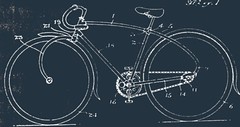
The patent filed on October 23, 1935 and designated Patent No. 358849 was granted on June 30, 1936 and outlined a bicycle CCM claimed was both novel in design and practical in its ability to absorb the shocks and vibrations of the road. Said to feature the "New Design Shock Absorbing Frame and Fork," the Flyte, available with either a 22" or 20" frame, was introduced by CCM in 1936 and produced until 1940.
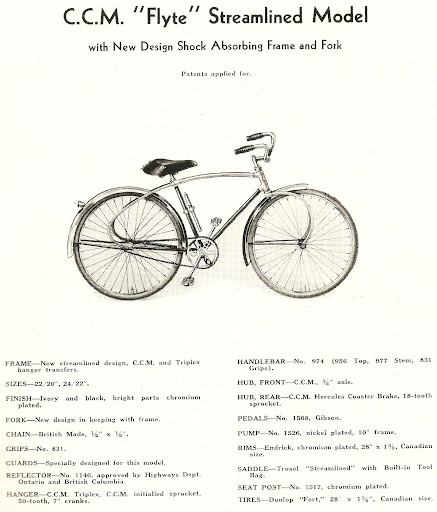
Company claims to the contrary the CCM Flyte was neither a revolutionary nor an entirely new design. The Schwinn company, a company with which Canada Cycle & Motor enjoyed a close relationship, had introduced the "Streamline Aerocycle" in 1934 and as noted Flyte collector Ken Martin points out (www.ccmflyte.com) the curved seatstays on the Fyte were not the first of its type since the same design could be found on the 1934 Monarck "Silver King."
While CCM marketed the Flyte as being stylish as well as functional, the fact remained that the model never became a big seller. As Martin points out, the company's decision not to resume production after the war indicates that the Flyte was not in great demand, unlike the CCM Motorbike model which remained a part of the company's product line for fifty years.
Retailing at $45.00 (as opposed to the CCM Roadster at $28.95), some maintained the Flyte was simply too expensive for a country mired in the depths of a depression. Longtime CCM dealer Tom Marshall disagrees. With the sale of motor cars slumping badly during the Depression, Marshall counters that the hard times were actually a boon to bicycle sales. The first year of the Flyte in 1936 saw bicycle production in Canada increase by 30% over the previous year and production continued to climb steadily during the next four years.
Furthermore, while it carried a considerable price tag, at the time the Flyte was still less expensive than the CCM Flyer ($80.00) and its delivery model ($55.00), both of which continued to sell during the Depression.
"That leaves design, which was probably too radical for the marketplace," maintains Marshall. "Had they simply streamlined a Motorbike without incorporating the cushioned stays and forks, it likely would have sold well, despite the price increase. It did for Schwinn and other U.S. companies."
Whatever the reason, the limited production numbers for the CCM Flyte ensured its future rarity, thus turning it into the Holy Grail for CCM bicycle collectors.

Harvey Peace, who had designed the Flyte, was also instrumental in the design of CCM's tube skate (1929) and the CCM Bike-Wagon (1932).
![]() A forty year veteran of CCM, Peace lived to see only one year of his bicycle's production, passing away, as he did, on December 12, 1936 at the age of 56. A champion bicycle racer in his youth, Peace was a popular member of the Weston community and at the time his funeral was said to be among the largest the town had ever had.
A forty year veteran of CCM, Peace lived to see only one year of his bicycle's production, passing away, as he did, on December 12, 1936 at the age of 56. A champion bicycle racer in his youth, Peace was a popular member of the Weston community and at the time his funeral was said to be among the largest the town had ever had.
"Friends and acquaintances from all walks of life gathered to do him tribute and the beautiful and numerous floral tributes were centred with a beautiful wreath from the CCM. This unusual floral piece was in the form of the CCM trademark finished in rare flowers, including orchids. ("Many Pay Tribute to Harvey W. Peace," VIM, Vol.24, No. 1, 1937, p.19)
In the end the true legacy of Harvey W. Peace was to be found in a bicycle design that would become the ultimate desire of CCM collectors around the world.
Readers told me: thanks for the memories

Last Saturday, in my weekly Gazette column, I wrote about a sports milestone from my youth: my first pair of Tacks.
I was surprised by the number of emails I received from Gazette readers with their own Tacks memories. Here are some of their stories:
Mike Prociuk, Kamloops, B.C.: Thank you for putting into words my feelings on the CCM Tacks skates. My 25-year-old pair finally wore out this year and are not repairable. No one I talk to relates to how I feel about them. On a brighter note, I managed to find a brand-new pair of 25-yearold Super Tacks on eBay and bought them.
Robbie Key, LaSalle: There were five boys in my family, and new skates were out of the question. I'm sure the used pair of Tacks I received were from a lucky boy who upgraded to Super Tacks. New or used, though, I was in my glory! Unfortunately I was never lucky enough to own a pair with the Tuuk blades. That was reserved for my brand-spanking-new pair of Micron "boot" skates that I found under the Christmas tree one year. They didn't make my game any better, but they helped me stay off my ankles, something those hard plastic inserts I used in my Tacks couldn't do. I wish I had saved my Tacks, too, even though they might not have fetched $10 today. I'm virtually wearing them right now, reminiscing about all the goals I scored as Guy Lafleur way back when.
Jamie Chouinard, Georgetown, Ont.: I am 52 and grew up in Beaconsfield. I can still remember my first pair of Tacks. I was playing peewee hockey for the rep team in Beaconsfield and my old skates (hand-medowns from my brother) were worn out with the blade sharpened to the base. My dad finally gave in and bought me Tacks. I can still remember putting them on for the first time. They fit like a glove, so comfortable that I wore them barefoot. What a feeling! I skated faster and better than any time before. I wore them at the Quebec Peewee Tournament in 1973.
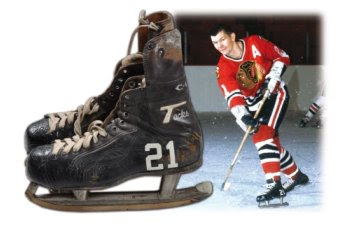
Glen McCrum, Toronto: My Tacks experience started when I was about 8 in the late 1960s out in the Townships. My father had bought my first pair of "regular" skates when our local arena was built in 1967 to first see if I would stick with organized hockey. I was fortunate enough to have a generous father who valued good equipment, and the next year, when it looked like this was going to be a regular activity for me, he sprang for a pair of Tacks. When the next season rolled round, I can still remember my father looking at the Tacks and comparing them to the Super Tacks. He noticed the front metal plate that attached the blade to the boot was bigger, extending to the edges of the boot on the Super Tacks - and he declared that was an important point for support, so from then on it was Super Tacks. My father liked hockey, having played a lot himself; his claim to fame was being a practice goalie for the Canadiens during the war years when teams regularly only carried one goaltender. I traded in my skates every year at our local dealer (which was a hardware store) and if I remember correctly a new pair cost him $20 or $25 each year. One thing that always started an argument was my father's desire to put a coating of clear shellac on the boots to protect the leather as I was on the ice so much. Watching my new skates get the treatment was always so disappointing. I still have the last pair he bought me in 1976, my last year of high school and intercity hockey before going off to CEGEP. I still play hockey in an adult league wearing CCM skates, the modern version minus the Tackaberry name - and no shellac.
Christian de Saint-Rome, Baie d'Urfé: Your column on Tacks skates was a very nice stroll down memory lane for me as well. My brother and I, who were outdoor rink rats, also had Bauer Black Panthers before I got Tacks at McNiece's sports store and he went for the Langes.
Rick Morgan, Kanata, Ont.: When I was at Macdonald College in Ste. Anne de Bellevue in 1966, at the first hockey practice of the year, coach/athletic director Bob Pugh talked about the three things you don't ever lend to anyone, ever: your wife, your money or your Tacks! Macdonald College, through McGill, used to pay for half the cost of your Tacks back then.
Paul LeBlanc, Beaconsfield: I acquired a pair of Tacks from the boyfriend of one of my older sisters; he died at a young age in 1955. I was the envy of my high-school bantam teammates for several years. On entering college, I bought myself a new pair of Tacks in 1962 from the memorable McNiece's, which was then on McGill College. I still have the McNiece's skates in the basement; I guess that's why we often have basements stocked with this stuff. They're still in great shape, that trademark kangaroo leather still pliable, the pre-Tuuk blades still rocketed sharp by ''Dusty'' (how appropriate a name!) at the old Wilson's Sports Store on Somerled/Cavendish. Thanks for helping me relive the memories.
The above is reprinted with the kind permission of Stu Cowan and the Montreal Gazette.





